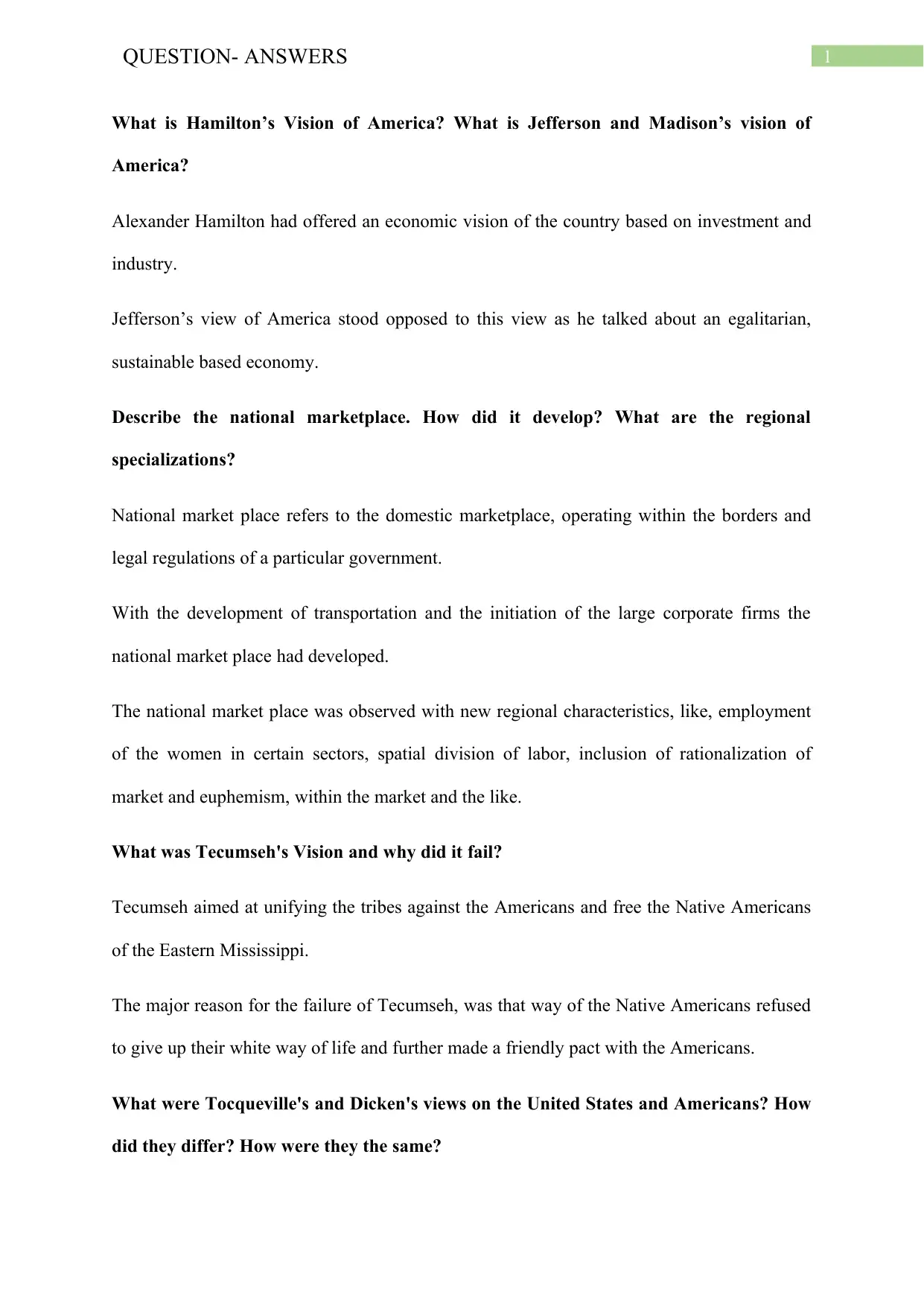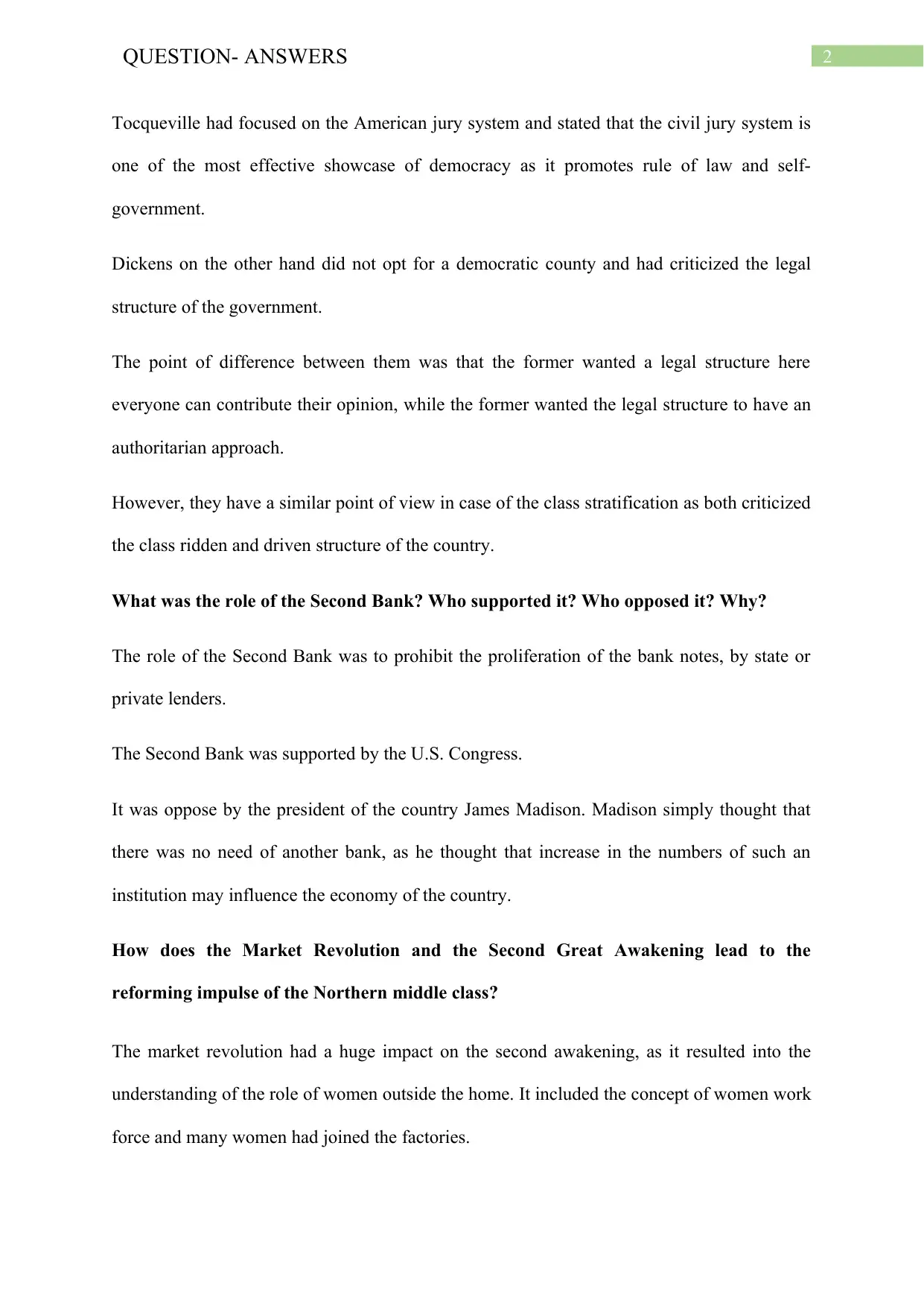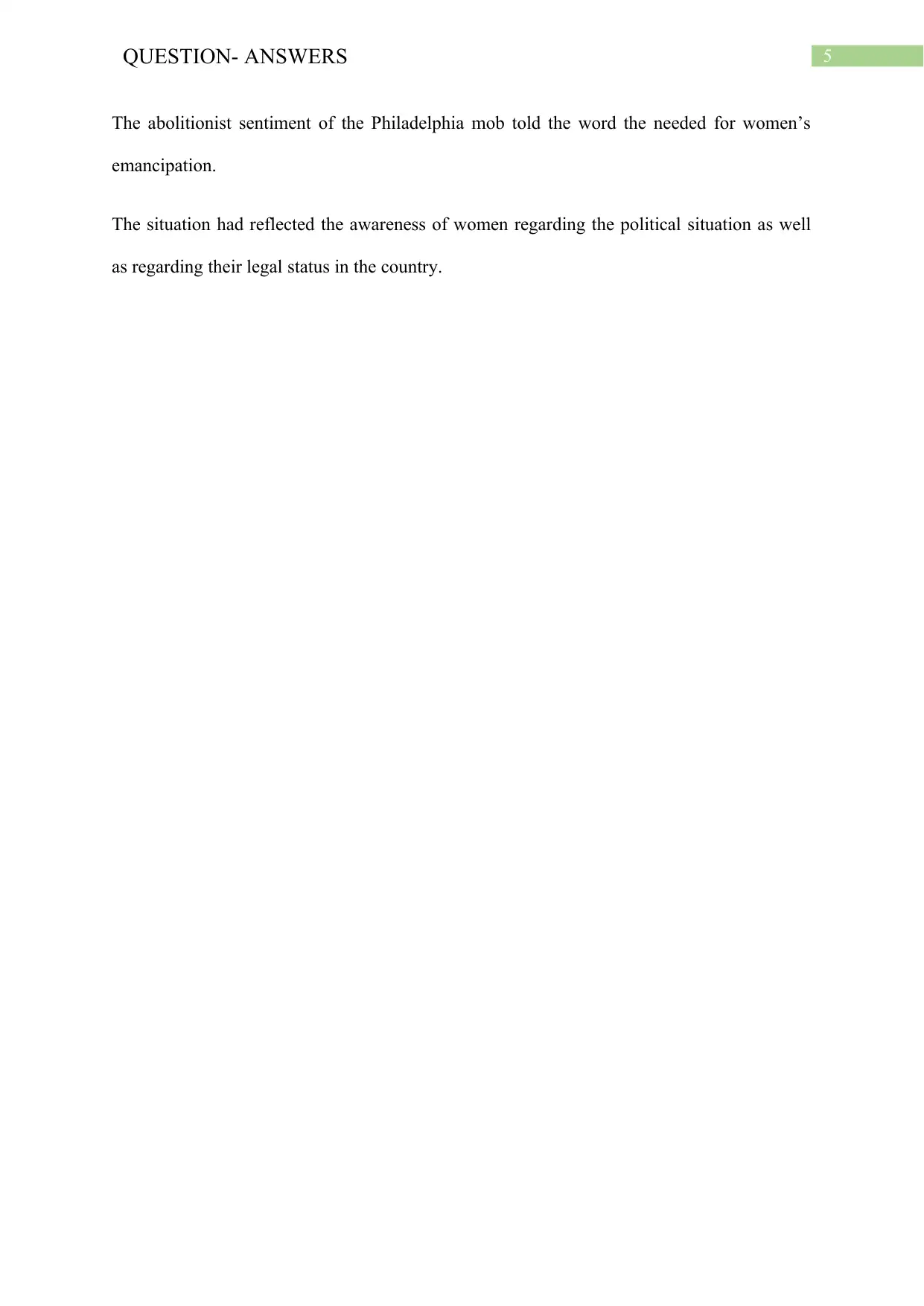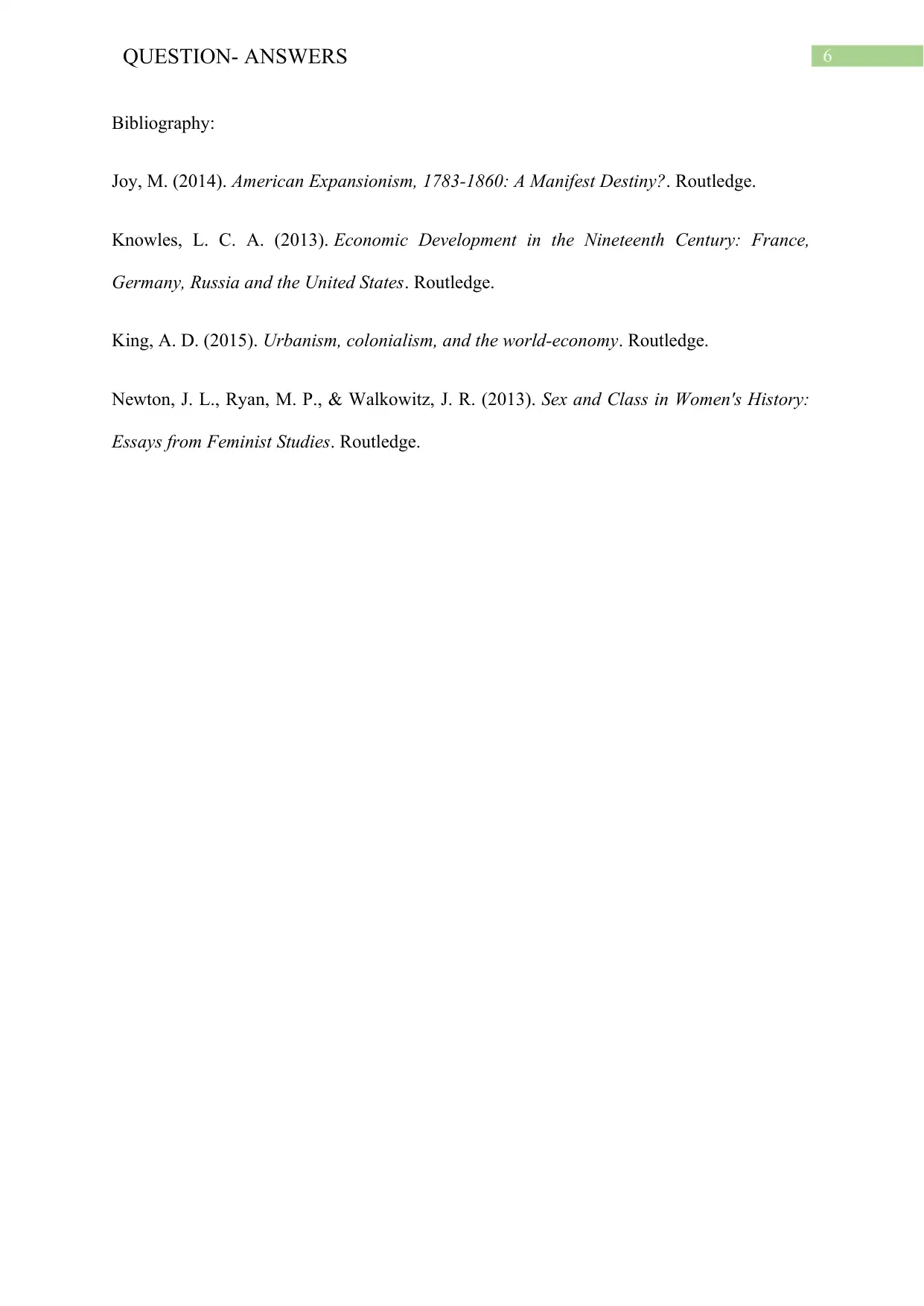US History: Exploring Visions, Conflicts, and Disunion
VerifiedAdded on 2022/10/02
|7
|1262
|25
Homework Assignment
AI Summary
This assignment provides a comprehensive overview of key themes in US History. It begins by contrasting the visions of Alexander Hamilton, Thomas Jefferson, and James Madison for America's future, examining their economic and social philosophies. The assignment then delves into the development of the national marketplace, regional specializations, and the rise and fall of Tecumseh's vision for Native American unity. It also explores the perspectives of Tocqueville and Dickens on the United States, highlighting their similarities and differences. Further, the assignment analyzes the role of the Second Bank, the impact of the Market Revolution and the Second Great Awakening on the Northern middle class, and the economics of slavery, including its influence on Southern politics and society. It examines the concept of Manifest Destiny, its goals, arguments, and detractors. Finally, the assignment discusses the causes of disunion, the role of the 1860 election, and the arguments of Grimke, including her message to Southern women and the implications of the burning of Philadelphia Hall. The assignment includes a bibliography of relevant sources.

Running head: QUESTION- ANSWERS
QUESTION- ANSWERS
Name of the Student:
Name of the University:
Author Note:
QUESTION- ANSWERS
Name of the Student:
Name of the University:
Author Note:
Paraphrase This Document
Need a fresh take? Get an instant paraphrase of this document with our AI Paraphraser

1QUESTION- ANSWERS
What is Hamilton’s Vision of America? What is Jefferson and Madison’s vision of
America?
Alexander Hamilton had offered an economic vision of the country based on investment and
industry.
Jefferson’s view of America stood opposed to this view as he talked about an egalitarian,
sustainable based economy.
Describe the national marketplace. How did it develop? What are the regional
specializations?
National market place refers to the domestic marketplace, operating within the borders and
legal regulations of a particular government.
With the development of transportation and the initiation of the large corporate firms the
national market place had developed.
The national market place was observed with new regional characteristics, like, employment
of the women in certain sectors, spatial division of labor, inclusion of rationalization of
market and euphemism, within the market and the like.
What was Tecumseh's Vision and why did it fail?
Tecumseh aimed at unifying the tribes against the Americans and free the Native Americans
of the Eastern Mississippi.
The major reason for the failure of Tecumseh, was that way of the Native Americans refused
to give up their white way of life and further made a friendly pact with the Americans.
What were Tocqueville's and Dicken's views on the United States and Americans? How
did they differ? How were they the same?
What is Hamilton’s Vision of America? What is Jefferson and Madison’s vision of
America?
Alexander Hamilton had offered an economic vision of the country based on investment and
industry.
Jefferson’s view of America stood opposed to this view as he talked about an egalitarian,
sustainable based economy.
Describe the national marketplace. How did it develop? What are the regional
specializations?
National market place refers to the domestic marketplace, operating within the borders and
legal regulations of a particular government.
With the development of transportation and the initiation of the large corporate firms the
national market place had developed.
The national market place was observed with new regional characteristics, like, employment
of the women in certain sectors, spatial division of labor, inclusion of rationalization of
market and euphemism, within the market and the like.
What was Tecumseh's Vision and why did it fail?
Tecumseh aimed at unifying the tribes against the Americans and free the Native Americans
of the Eastern Mississippi.
The major reason for the failure of Tecumseh, was that way of the Native Americans refused
to give up their white way of life and further made a friendly pact with the Americans.
What were Tocqueville's and Dicken's views on the United States and Americans? How
did they differ? How were they the same?

2QUESTION- ANSWERS
Tocqueville had focused on the American jury system and stated that the civil jury system is
one of the most effective showcase of democracy as it promotes rule of law and self-
government.
Dickens on the other hand did not opt for a democratic county and had criticized the legal
structure of the government.
The point of difference between them was that the former wanted a legal structure here
everyone can contribute their opinion, while the former wanted the legal structure to have an
authoritarian approach.
However, they have a similar point of view in case of the class stratification as both criticized
the class ridden and driven structure of the country.
What was the role of the Second Bank? Who supported it? Who opposed it? Why?
The role of the Second Bank was to prohibit the proliferation of the bank notes, by state or
private lenders.
The Second Bank was supported by the U.S. Congress.
It was oppose by the president of the country James Madison. Madison simply thought that
there was no need of another bank, as he thought that increase in the numbers of such an
institution may influence the economy of the country.
How does the Market Revolution and the Second Great Awakening lead to the
reforming impulse of the Northern middle class?
The market revolution had a huge impact on the second awakening, as it resulted into the
understanding of the role of women outside the home. It included the concept of women work
force and many women had joined the factories.
Tocqueville had focused on the American jury system and stated that the civil jury system is
one of the most effective showcase of democracy as it promotes rule of law and self-
government.
Dickens on the other hand did not opt for a democratic county and had criticized the legal
structure of the government.
The point of difference between them was that the former wanted a legal structure here
everyone can contribute their opinion, while the former wanted the legal structure to have an
authoritarian approach.
However, they have a similar point of view in case of the class stratification as both criticized
the class ridden and driven structure of the country.
What was the role of the Second Bank? Who supported it? Who opposed it? Why?
The role of the Second Bank was to prohibit the proliferation of the bank notes, by state or
private lenders.
The Second Bank was supported by the U.S. Congress.
It was oppose by the president of the country James Madison. Madison simply thought that
there was no need of another bank, as he thought that increase in the numbers of such an
institution may influence the economy of the country.
How does the Market Revolution and the Second Great Awakening lead to the
reforming impulse of the Northern middle class?
The market revolution had a huge impact on the second awakening, as it resulted into the
understanding of the role of women outside the home. It included the concept of women work
force and many women had joined the factories.
⊘ This is a preview!⊘
Do you want full access?
Subscribe today to unlock all pages.

Trusted by 1+ million students worldwide

3QUESTION- ANSWERS
The second great awakening had induced among the public a strong sense of work ethics,
which resulted into the formation of the Middle Class, and a middle class culture. The middle
class culture was also knows as to be a subculture, where these middle class people were
educated and had a good amount of money to create their own sense of fashion and life
choices and life styles.
What are the economics of slavery? How did the economics of slavery shape Southern
politics and Southern society and social hierarchy?
During the onset of 19th century, people from Africa were transported to America, to include
them within the workforce and then further an economic base was created upon the same.
According to the political scientists, the expansion and the base of slavery had created the
racial orientation among the white population, and restricted the emancipation of the African
Americans.
This racial orientation had created a social inequality and a social hierarchy within the social
structure of the Southern America.
What is meant by Manifest Destiny? What are the goals of the proponents of Manifest
Destiny? How are these goals influenced by sectionalism? What are the arguments of
the detractors of Manifest Destiny?
Manifest Destiny was an idea developed by the White Americans to steer out all the Native
Americans and create a land of white gentlemen.
The goals of this measure was to create a white superiority within the land, and continental
expansionism towards the sea.
The second great awakening had induced among the public a strong sense of work ethics,
which resulted into the formation of the Middle Class, and a middle class culture. The middle
class culture was also knows as to be a subculture, where these middle class people were
educated and had a good amount of money to create their own sense of fashion and life
choices and life styles.
What are the economics of slavery? How did the economics of slavery shape Southern
politics and Southern society and social hierarchy?
During the onset of 19th century, people from Africa were transported to America, to include
them within the workforce and then further an economic base was created upon the same.
According to the political scientists, the expansion and the base of slavery had created the
racial orientation among the white population, and restricted the emancipation of the African
Americans.
This racial orientation had created a social inequality and a social hierarchy within the social
structure of the Southern America.
What is meant by Manifest Destiny? What are the goals of the proponents of Manifest
Destiny? How are these goals influenced by sectionalism? What are the arguments of
the detractors of Manifest Destiny?
Manifest Destiny was an idea developed by the White Americans to steer out all the Native
Americans and create a land of white gentlemen.
The goals of this measure was to create a white superiority within the land, and continental
expansionism towards the sea.
Paraphrase This Document
Need a fresh take? Get an instant paraphrase of this document with our AI Paraphraser

4QUESTION- ANSWERS
The arguments of the detractors regarding this were, firstly, the Manifest Destiny had a
religious influence, secondly, it had a sense f mission and thirdly, it is one of the darkest
history of America.
The regional loyalty is known as Sectionalism, and their ideology of white expansion made
them belief that they must acquire lands from Atlantic to the Pacific Ocean. This idea had
contributed in the Manifest Destiny and the goals were taken accordingly.
Why did disunion occur? What role does the election of 1860 play?
The reasons for the occurrence of Disunion were, the class conflict among the ruling elites
and the clash of the political and social policies. Also, the structural divergence between
north and south contributed in the disunion.
The election of 1860 made Lincoln to rise in power which had resulted into the secession of
slavery in the south and at the same time, to the ongoing civil war that had destructed many
of the states of south. This resulted into the disunion by the splitting of the Democratic Party.
How effective are Grimke's arguments? How is her message to Southern women
different from the Philadelphia address? What are the similarities? What does the
burning of Philadelphia Hall by a mob tell you about abolitionist sentiments in the
North in the 1830s? What does it tell you about the acceptance of women into the
political sphere?
The arguments of Grimke regarding rights had inspired the women.
The messages differed for South and for Philadelphia. In south she talked about the slavery
and in Philadelphia she focused more on the position of the women.
In both cases she talked about the rights.
The arguments of the detractors regarding this were, firstly, the Manifest Destiny had a
religious influence, secondly, it had a sense f mission and thirdly, it is one of the darkest
history of America.
The regional loyalty is known as Sectionalism, and their ideology of white expansion made
them belief that they must acquire lands from Atlantic to the Pacific Ocean. This idea had
contributed in the Manifest Destiny and the goals were taken accordingly.
Why did disunion occur? What role does the election of 1860 play?
The reasons for the occurrence of Disunion were, the class conflict among the ruling elites
and the clash of the political and social policies. Also, the structural divergence between
north and south contributed in the disunion.
The election of 1860 made Lincoln to rise in power which had resulted into the secession of
slavery in the south and at the same time, to the ongoing civil war that had destructed many
of the states of south. This resulted into the disunion by the splitting of the Democratic Party.
How effective are Grimke's arguments? How is her message to Southern women
different from the Philadelphia address? What are the similarities? What does the
burning of Philadelphia Hall by a mob tell you about abolitionist sentiments in the
North in the 1830s? What does it tell you about the acceptance of women into the
political sphere?
The arguments of Grimke regarding rights had inspired the women.
The messages differed for South and for Philadelphia. In south she talked about the slavery
and in Philadelphia she focused more on the position of the women.
In both cases she talked about the rights.

5QUESTION- ANSWERS
The abolitionist sentiment of the Philadelphia mob told the word the needed for women’s
emancipation.
The situation had reflected the awareness of women regarding the political situation as well
as regarding their legal status in the country.
The abolitionist sentiment of the Philadelphia mob told the word the needed for women’s
emancipation.
The situation had reflected the awareness of women regarding the political situation as well
as regarding their legal status in the country.
⊘ This is a preview!⊘
Do you want full access?
Subscribe today to unlock all pages.

Trusted by 1+ million students worldwide

6QUESTION- ANSWERS
Bibliography:
Joy, M. (2014). American Expansionism, 1783-1860: A Manifest Destiny?. Routledge.
Knowles, L. C. A. (2013). Economic Development in the Nineteenth Century: France,
Germany, Russia and the United States. Routledge.
King, A. D. (2015). Urbanism, colonialism, and the world-economy. Routledge.
Newton, J. L., Ryan, M. P., & Walkowitz, J. R. (2013). Sex and Class in Women's History:
Essays from Feminist Studies. Routledge.
Bibliography:
Joy, M. (2014). American Expansionism, 1783-1860: A Manifest Destiny?. Routledge.
Knowles, L. C. A. (2013). Economic Development in the Nineteenth Century: France,
Germany, Russia and the United States. Routledge.
King, A. D. (2015). Urbanism, colonialism, and the world-economy. Routledge.
Newton, J. L., Ryan, M. P., & Walkowitz, J. R. (2013). Sex and Class in Women's History:
Essays from Feminist Studies. Routledge.
1 out of 7
Your All-in-One AI-Powered Toolkit for Academic Success.
+13062052269
info@desklib.com
Available 24*7 on WhatsApp / Email
![[object Object]](/_next/static/media/star-bottom.7253800d.svg)
Unlock your academic potential
Copyright © 2020–2025 A2Z Services. All Rights Reserved. Developed and managed by ZUCOL.